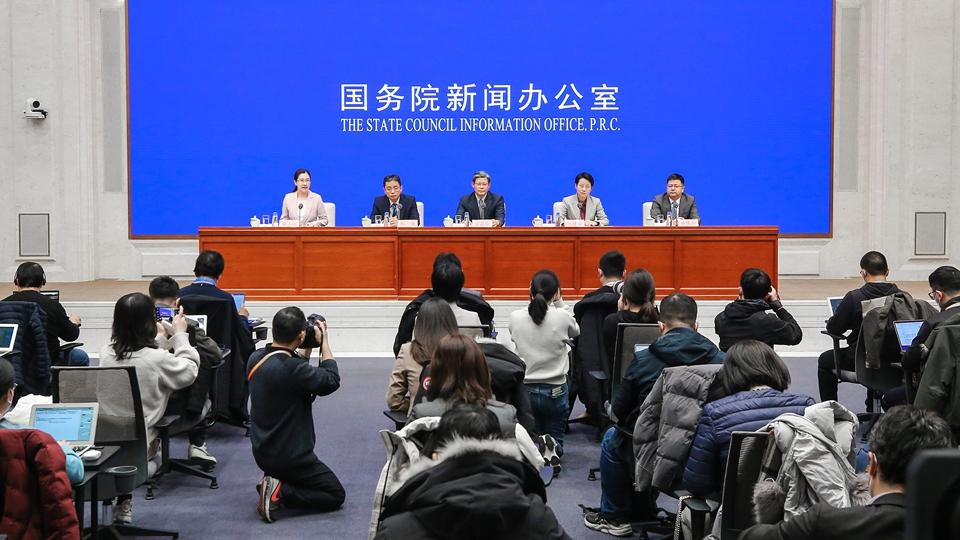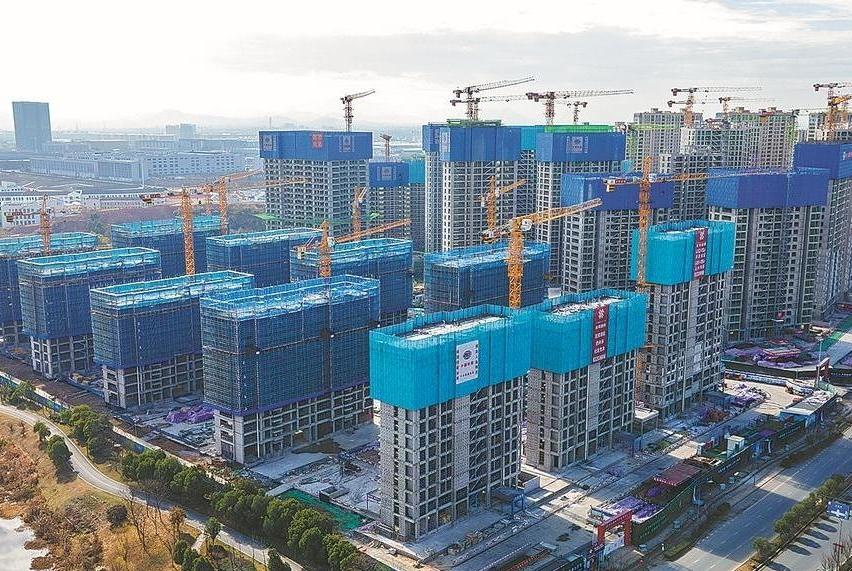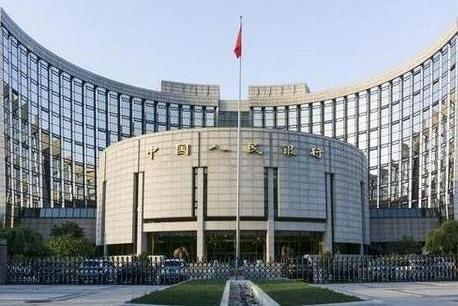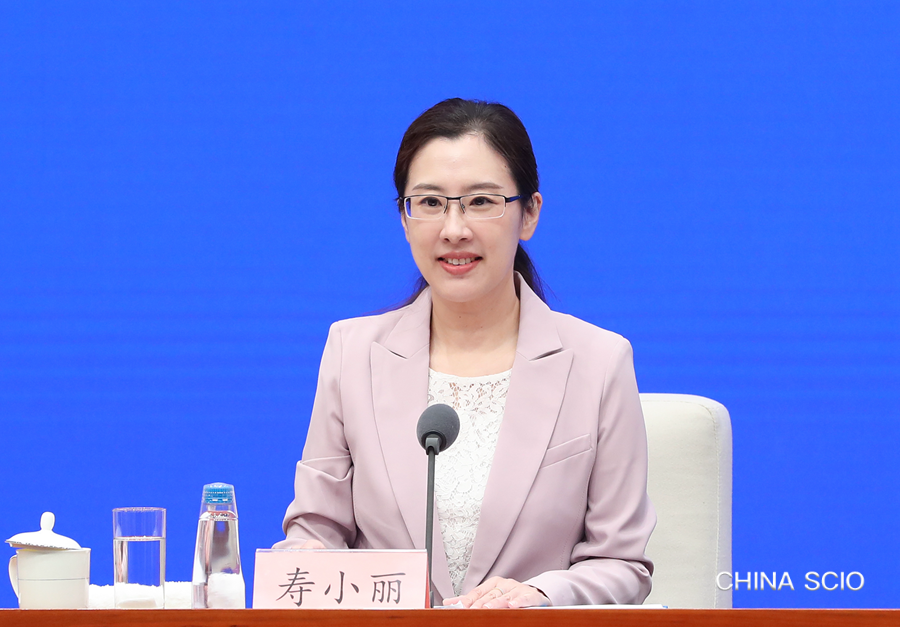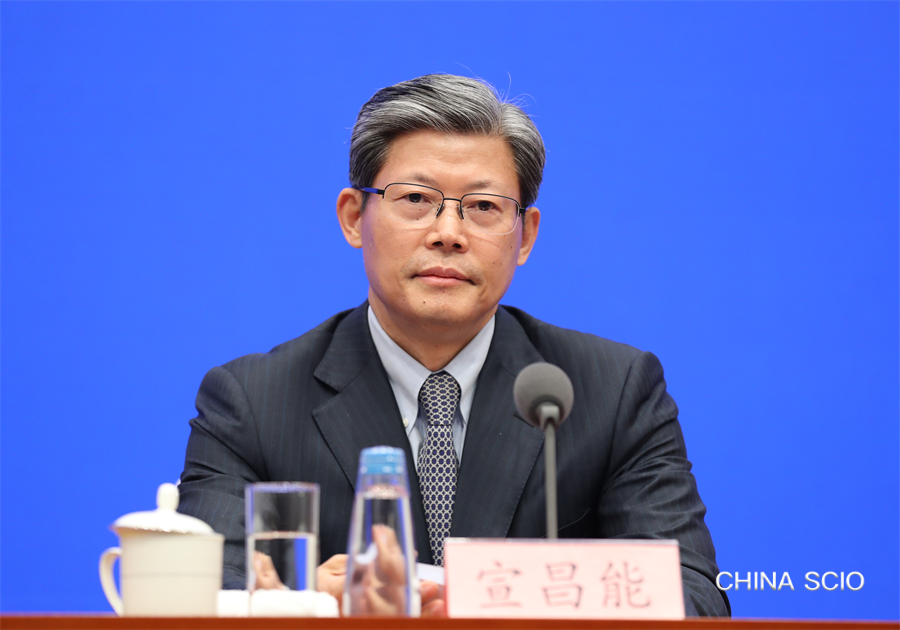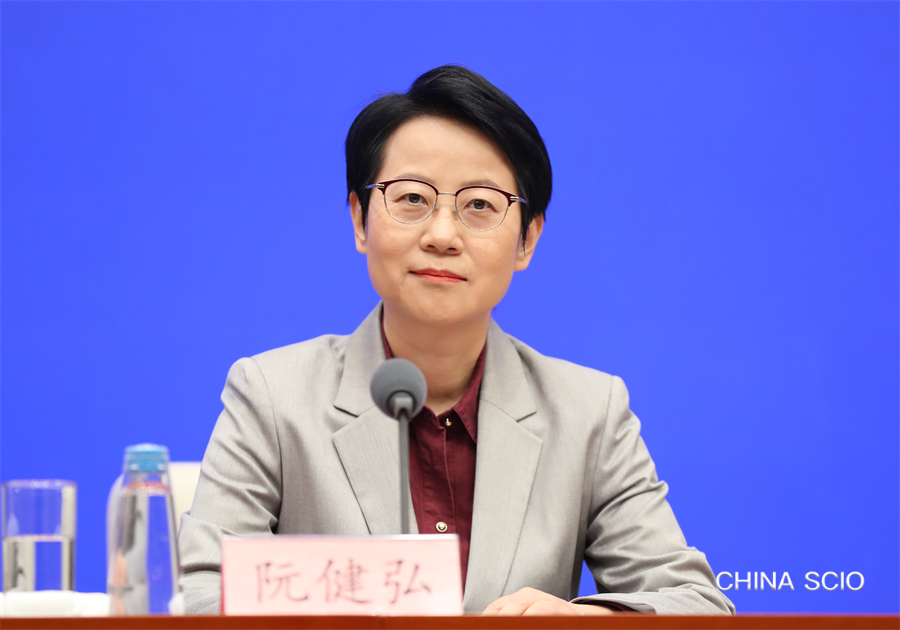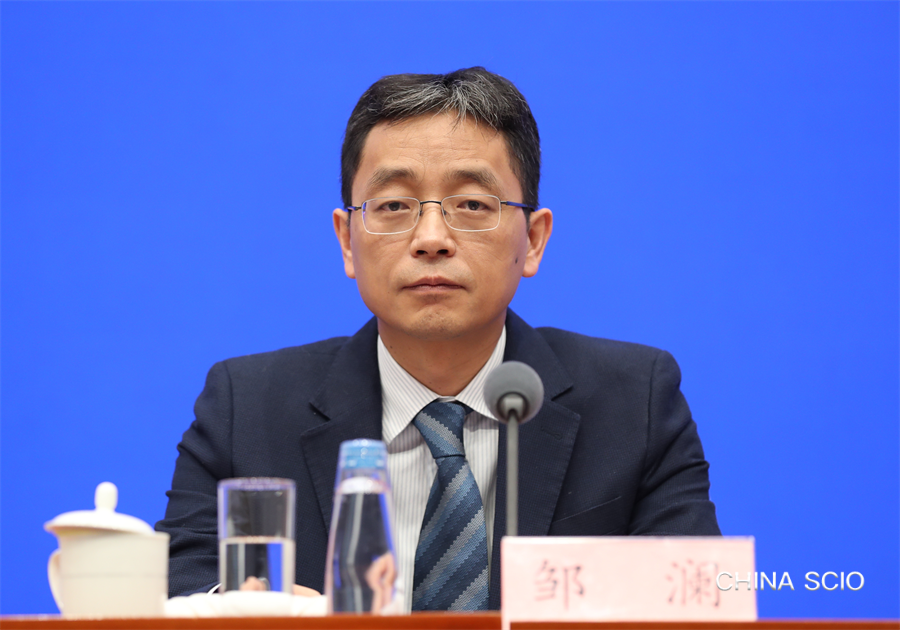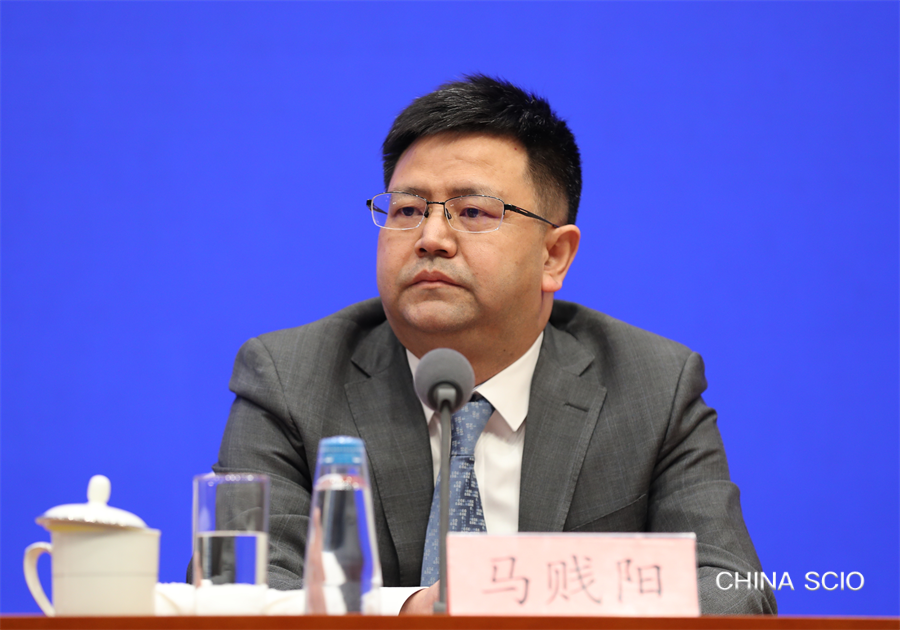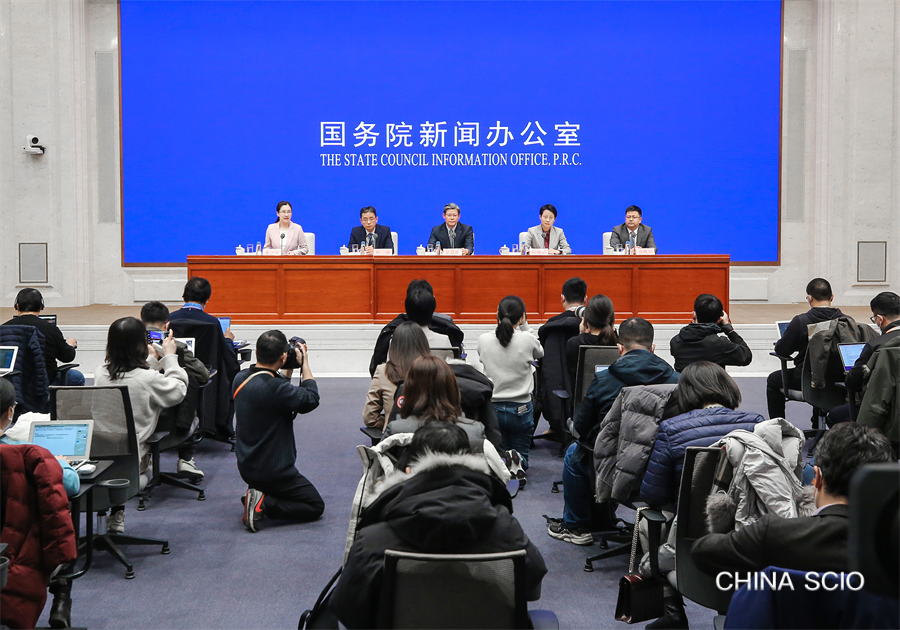.
Read in Chinese
Speakers:
Mr. Xuan Changneng, deputy governor of the People's Bank of China (PBC)
Ms. Ruan Jianhong, spokesperson of the PBC and director general of the Statistics and Analysis Department of the PBC
Mr. Zou Lan, director general of the Monetary Policy Department of the PBC
Mr. Ma Jianyang, an official of the Financial Market Department of the PBC
Chairperson:
Shou Xiaoli, deputy director general of the Press Bureau of the State Council Information Office (SCIO) and spokesperson of the SCIO
Date:
Jan. 13, 2023
Shou Xiaoli:
Ladies and gentlemen, good afternoon. Welcome to the second press conference held by the State Council Information Office (SCIO) this afternoon. We have invited Mr. Xuan Changneng, deputy governor of the People's Bank of China (PBC), to brief you on China's financial statistics in 2022 and take your questions. Also joining us today are Ms. Ruan Jianhong, spokesperson of the PBC and director general of the Statistics and Analysis Department of the PBC; Mr. Zou Lan, director general of the Monetary Policy Department of the PBC; and Mr. Ma Jianyang, an official of the Financial Market Department of the PBC.
Now, I will give the floor to Mr. Xuan Changneng.
Xuan Changneng:
Friends from the media, good afternoon. In 2022, faced with unexpected factors at home and abroad, under the strong leadership of the Central Committee of the Communist Party of China (CPC) with Comrade Xi Jinping at its core, the PBC firmly acted on the decisions and deployments of the CPC Central Committee and the State Council and the requirements of the Financial Stability and Development Committee under the State Council, stepped up the implementation of prudent monetary policies, adopted the policy package and follow-up policies for keeping the economy stable, took solid measures to serve the real economy, and made resolute contributions to maintaining a stable macroeconomic performance. On Jan. 10, the PBC released the Financial Statistics Report (2022). The data shows that China's financial system operated smoothly in 2022, and the financial sector provided stronger and higher-quality support for the real economy.
First, liquidity in the banking system maintained reasonably ample, and the growth in total credit became more stable. In 2022, the PBC lowered the required reserve ratio (RRR) twice, providing the real economy with more than 1 trillion yuan in long-term liquidity; turned in surplus profits of over 1.13 trillion yuan; and used various methods such as re-lending and rediscounting, medium-term lending facilities, and open market operations to release liquidity, thus creating a favorable liquidity environment for keeping the macroeconomic performance stable. Broad money supply (M2) increased by 11.8% year on year, 2.8 percentage points higher than that at the end of the previous year. RMB loans grew by 21.31 trillion yuan, surpassing the amount recorded in 2021 by 1.36 trillion yuan. Aggregate financing in the economy increased by 9.6% – 32.01 trillion yuan – year on year, which was 668.9 billion yuan more than that in the previous year.
Second, credit support for key fields and weak links of the real economy was strengthened. The credit structure was continuously improved. In 2022, the PBC introduced a range of targeted structural monetary policy tools for groups in difficulty and key fields, helping to keep the macroeconomic performance stable. The outstanding balance of loans to the manufacturing industry increased by 36.7% year on year, 25.6 percentage points higher than the growth rate of loans overall. The outstanding balance of loans to small- and medium-sized scientific and technological enterprises increased by 24.3% year on year, 13.2 percentage points higher than the growth rate of loans overall. The outstanding balance of loans to specialized and sophisticated enterprises that produce new and unique products increased by 24% year on year, 12.9 percentage points higher than the growth rate of loans overall. The outstading balance of inclusive loans to micro and small businesses increased by 23.8% year on year, 12.7 percentage points higher than the growth rate of loans overall. A total of 56.52 million micro and small businesses received the inclusive loans, a year-on-year increase of 26.8%. At the same time, the PBC guided policy and development banks to free up 739.9 billion yuan through policy and developmental financial instruments, and made full use of 800 billion yuan in new credit quotas to mainly support infrastructure development. By the end of 2022, the outstanding balance of medium- and long-term loans to the infrastructure sector increased by 13% year-on-year, 1.9 percentage points higher than the growth rate of loans overall.
Third, overall financing costs of the real economy dropped significantly. While major European and American economies raised interest rates sharply and swiftly, China's loan prime rate (LPR) reforms continued to deliver benefits. The one-year and five-year LPRs were lowered by 15 and 35 basis points, respectively, helping to reduce overall financing costs of the real economy. In 2022, the weighted average interest rate on newly issued corporate loans was 4.17%, 34 basis points lower than the previous year. Meanwhile, the PBC established a market-based adjustment mechanism for deposit interest rates to keep the cost of bank liabilities stable. In 2022, the weighted average interest rate of new time deposits was 11 basis points lower than that of the previous year.
The year 2023 is the start of fully implementing the guiding principles of the 20th CPC National Congress. The PBC will follow the guidance of Xi Jinping Thought on Socialism with Chinese Characteristics for a New Era, thoroughly act on the guiding principles of the 20th CPC National Congress and the Central Economic Work Conference, work unswervingly both to consolidate and develop the public sector and to encourage, support, and guide development of the non-public sector, stay committed to the general principle of pursuing progress while ensuring stability, make prudent monetary policy more targeted and effective, focus on expanding effective demand and deepening supply-side structural reform, and contribute to high-quality and moderate economic growth.
Thank you.
Shou Xiaoli:
Now we will open the floor for questions. Please identify the media outlet you represent before raising a question.
_ueditor_page_break_tag_
Reuters:
The Central Economic Work Conference stressed that the prudent monetary policy should be targeted and effective this year, with reasonable and sufficient liquidity to be maintained. In this context, is there room to further cut interest rates and RRR? Will structural tools be used more? Thanks.
Xuan Changneng:
As mentioned in my opening remarks, the prudent monetary policy aims to ensure better coordination in expanding domestic demand and advancing supply-side structural reform. On the one hand, we will make efforts to support the expansion of domestic demand. Reasonable and ample liquidity will be maintained. Financial institutions will be guided to act in accordance with the market-oriented and law-based principle, and properly manage the scale and pace of granting credit. We will put forward measures in a timely manner so that they will produce effects early on. The prudent monetary policy will proactively coordinate with fiscal and social policies, providing greater support for enterprises to stabilize and expand employment and for key groups to start businesses and find jobs, and increasing the incomes of urban and rural residents in multiple channels. We will ensure strong support for the aggregate demand of society, but in a reasonable and appropriate way. A deluge of strong stimulus policies will be avoided. We will work to ensure the balance between stabilizing growth, employment and price. On the other hand, we will give better play to the guiding role of structural monetary policy instruments. We will continue to make better use of the carbon emission reduction facility and the central bank lending for sci-tech innovation and others. Support will be provided for accelerating the building of a modern industrial system. Preferential policies, such as the instrument supporting inclusive loans for micro and small businesses, will be better implemented. Strong support will be given to the construction of key infrastructure and major projects in areas such as energy, transportation and water conservancy. Financial services for rural revitalization will be enhanced. We will work to achieve a high level dynamic equilibrium between effective supply and demand.
Currently, as epidemic prevention and control measures have been optimized and economic circulation has returned to normal, the confidence of micro entities will be gradually restored and their vitality gradually unleashed. We will take more measures to boost market confidence and stimulate the vitality of micro entities. First, we will work to lower the overall financing costs for businesses, reduce costs for personal consumption, and alleviate the debt burden for micro entities to improve people's spending power and enterprises' investment capacity. Second, we will stay committed to unswervingly consolidating and developing the public sector and unswervingly encouraging, supporting and guiding the development of the non-public sector. We will guide financial institutions to strengthen and refine financial services, step up support for private micro and small enterprises in the manufacturing and service sectors, and further promote the instrument supporting debt financing of private enterprises. Third, we will encourage spending on housing, automobiles, and other big-ticket items, and strengthen comprehensive financial support for services consumption with a focus on key areas such as education, culture and sports. Fourth, we will maintain financing for the real estate sector in a steady and orderly manner. Guided by the principle that houses are for living in, not for speculation, we will adopt city-specific measures to implement a differentiated housing credit policy. We will make full use of policy instruments, including a special lending facility to ensure the delivery of pre-sold housing projects and loan programs to support pre-sold housing project delivery, to protect the legitimate rights and interests of homebuyers. We will carry out programs to improve the balance sheets of quality real estate enterprises and take effective measures to prevent and diffuse risks for quality leading real estate enterprises. We will improve financial policies to support rental properties and advance a smooth transition of the real estate sector to a new model of development. Thank you.
Zou Lan:
I would like to make a few more points for your reference. The structural monetary policy instruments that have been mentioned have attracted wide attention from all sectors of society. Over the past two years, the PBC has conscientiously implemented the decisions and plans of the CPC Central Committee and the State Council, giving full play to the role of the monetary policy in adjusting both the aggregate and structure. Structural monetary policy instruments have been frequently applied. Especially since last year, many monetary policy instruments have been introduced. Generally, structural monetary policy instruments focus on key sectors, adopt reasonable and moderate approaches, and build up ample room for maneuvering. As of the end of last year, the outstanding value of structural monetary policy instruments stood at about 6.4 trillion yuan. They have played an active role in guiding financial institutions to ensure appropriate credit supply, allocating more financial resources to key areas and weak links, keeping a steady growth in the aggregate monetary and credit supply, and stabilizing the economy's fundamentals.
China's structural monetary policy mainly focuses on key areas and weak links in the national economy, including inclusive finance, green development, and scientific and technological innovation. Specific structural monetary policy instruments are regularly released on the official website of the PBC. You can keep up to date on them. Recently, we have been working on introducing some other structural instruments. These instruments mainly provide support for ensuring stability in the real estate market, including loan programs to support pre-sold housing project delivery and rental properties. We will release more details after the introduction of these structural instruments.
_ueditor_page_break_tag_
Shangyou News:
Statistics show that China's aggregate financing to the real economy (AFRE) in December rose slightly on a year-on-year basis. What factors influenced the AFRE at the end of the year? How do you evaluate the overall performance of the AFRE in 2022? Thank you.
Ruan Jianhong:
This reporter raised two questions. The first question is about the AFRE in December. The second one is about the AFRE in the whole year. First, I will answer the question about the AFRE in December.
In December 2022, the country's increment in the AFRE reached 1.31 trillion yuan, a year-on-year decrease of 1.05 trillion yuan. That was mainly due to a relatively large reduction in bond financing. On one hand, financing of government bonds stood at 280.9 billion yuan, a year-on-year decrease of 886.5 billion yuan. That was because government bonds were issued early this year. The financing of government bonds in the previous 11 months amounted to 6.84 trillion yuan, a year-on-year increase of about 1 trillion yuan. Financial support for the real economy was strengthened in advance. On the other hand, fluctuations in the bond market affected the financing of corporate bonds to some extent. The financing of corporate bonds saw a net decrease of 488.7 billion yuan in December, a year-on-year decrease of 705.4 billion yuan. Despite the slight increase of the AFRE this month, RMB loans issued by financial institutions to the real economy — an important constituent of the AFRE — increased by 1.44 trillion yuan, a year-on-year increase of 405.1 billion yuan. Credit support for the real economy continued to be enhanced.
Now let's take a look at the AFRE for the entire year. Overall, the AFRE in 2022 increased by 32.01 trillion yuan, 668.9 billion yuan more than 2021's increment. The financial system played a significant role in supporting the real economy. Let's look at the structural data.
First, financial institutions strengthened credit support for the real economy. In 2022, RMB loans issued by financial institutions to the real economy increased by 20.91 trillion yuan, 974.6 billion yuan more than 2021's increment.
Second, the net financing of government bonds kept growing steadily. In 2022, the net financing of government bonds stood at 7.12 trillion yuan, and the increment was 107.4 billion yuan more than that of the same period of the previous year.
Third, off-balance-sheet financing saw a markedly narrower decline. Please note that it was a markedly narrower decline in off-balance-sheet financing. In 2022, entrusted loans increased by 357.9 billion yuan, 527.5 billion yuan more than 2021's increment. Trust loans decreased by 600.3 billion yuan, 1.41 trillion yuan less than 2021's decrement. Undiscounted bankers' acceptances reduced by 341.1 billion yuan, 150.5 billion yuan less than 2021's decrement.
In addition, the financing of corporate bonds saw a less increase. In 2022, the net financing of corporate bonds reached 2.05 trillion yuan, and the increase was 1.24 trillion yuan less than the same period of the previous year. Equity financing was 1.18 trillion yuan, roughly in line with that of the previous year.
Thank you.
_ueditor_page_break_tag_
Hong Kong Bauhinia Magazine:
How was credit growth in the real estate sector in 2022? In the recent meeting on credit work, it was proposed to improve the balance sheets of good-quality real estate developers. What new policies will be adopted to ensure the stable development of the real estate sector? Thank you.
Zou Lan:
Thank you for your questions. Positive circulation in the real estate sector is of great significance for the sound development of the economy. The Central Economic Work Conference has made clear that the steady development of the real estate market must be ensured; reasonable financing needs of the real estate sector should be met; effective measures should be taken to prevent and mitigate risks associated with leading real estate developers; different policies should be adopted in different cities as appropriate to their local conditions; people's justified housing need and the need to improve their housing situation should be supported; the principle that houses are for living in, not for speculation should be upheld; and the smooth transition of the real estate sector toward new development models should be advanced. In response to the adjustments in the real estate market, the PBC, together with relevant departments, has worked to improve both supply and demand in accordance with the arrangements of the CPC Central Committee and the State Council to promote stability in the real estate market. As relevant policies gradually produce effects, we notice that recently the financing environment in the real estate sector, especially for quality real estate developers, has been significantly improved. I would like to present two figures here. From September to November 2022, loans to real estate development increased by over 170 billion yuan, 200 billion yuan more than the increment of the same period of the previous year. In the fourth quarter of last year, bonds issued by real estate developers in China were worth over 120 billion yuan, a year-on-year increase of 22%. According to the specific arrangement made by the Central Economic Work Conference, the PBC and relevant departments recently proposed to improve the balance sheets of good-quality real estate developers. Earlier this year, the PBC and the China Banking and Insurance Regulatory Commission jointly held a symposium on credit work. That proposal was an important part of the symposium, which has also been released on the official website of the PBC. According to information publicly disclosed by developers, over the past decade, the balance sheets of the real estate sector in China have gone through rapid expansion. The assets of the top 50 real estate developers in China have grown by 10 times, with some growing by 23 times. Meanwhile, the liability structure of the real estate sector is highly diversified, among which financial liabilities only account for 31%, including 14% in development loans from banks, 9% in foreign and domestic bonds, and 8% in financing via non-standard credit assets. Others mainly consist of funding for projects in advance from upstream and downstream enterprises, making up 30%, the personal house payments collected in advance, accounting for 32%, and delayed tax payments and payments on land purchases, representing 7%.
To implement the arrangement made by the Central Economic Work Conference and prevent the spreading of risk from property developers with financial problems to good-quality ones, relevant departments have drafted an action plan to improve the balance sheets of good-quality real estate developers. Targeting quality property developers who focus on their core businesses and are characterized by compliant operation, good qualification, and of systematical importance, the action plan gives priority to advancing 21 tasks in four aspects, including activating assets, sustaining liabilities, replenishing equity, and improving expectations. By taking a holistic approach, the plan aims to improve the cash flows of high-quality developers and guide their balance sheets back to the safety zone. The tasks include both measures to ensure the implementation of the policies that have been issued and a series of new measures, such as setting up special re-lending for national asset management companies and loan programs supporting rental properties. There is no specific list of good-quality real estate developers in the plan, and financial institutions can make their own decisions.
Concerning the "three red lines" rules on real estate developers, the plan has specified that the rules targeting 30 pilot developers will be optimized. While the overall framework of the rules remains unchanged, some parameters will be improved.
That's all for my answers. Thank you.
_ueditor_page_break_tag_
Nikkei:
From December 2022, the digital RMB was included in calculating the amount of currency in circulation (M0). What is the purpose of doing so? Is it related to its official issuance in the future?
Xuan Changneng:
Thank you for your questions. The digital RMB is a digital version of the legal tender issued by the PBC. Like the physical yuan, the digital yuan is part of the currency. From the perspective of statistics and management, the physical and digital yuan should be tallied, analyzed and managed together. In recent years, as pilot schemes for digital RMB have advanced, application scenes have expanded and transaction volume and stock have increased. Relevant management and statistical systems have been improved. Adding the digital RMB to the calculation of money in circulation (M0) can provide a more accurate result of the latter. By the end of 2022, the amount of digital RMB in circulation was 13.61 billion yuan. With digital RMB included, the year-on-year increase in M0 was 15.3%.
According to the requirement of steadily promoting the research and development of digital currency in the 14th Five-Year Plan, the PBC will advance research and development pilots of digital RMB in an orderly manner, continue to improve the top-level design and the construction of the ecosystem, and strengthen the innovation of products and applications. We will gradually establish a sound management framework and continue to build upon the pilot plan's success. Financial statistics will monitor the issuance of digital RMB in the future and release relevant data to the public on a timely basis.
Thank you.
_ueditor_page_break_tag_
Tianmu News:
The Central Economic Work Conference mentioned working unswervingly both to consolidate and develop the public sector and to encourage, support and guide the development of the non-public sector. This has created policy support and public opinion base that encourage the private economy and private enterprises to expand and strengthen. What measures will the PBC take to bolster the development of the private sector? Thank you.
Ma Jianyang:
Thank you for your question, which is of much concern to many people. In recent years, the Chinese economy has faced downward pressure due to the repeated impact of the pandemic and the unstable international situation, while private companies have faced more difficulties. According to the decisions and arrangements of the CPC Central Committee and the State Council, the PBC has created structural monetary policies, improved credit support policies, expanded diversified financing channels and continued to optimize the financing environment for private micro and small enterprises. Mr. Xuan presented statistics about inclusive loans to micro and small businesses in detail, and I will provide two more pieces of data. Inclusive loans to micro and small businesses have grown by around 20% for four straight years. In November 2022, the weighted average interest rate of newly issued inclusive loans to micro and small businesses was at 4.9%, a relatively low level. Micro and small businesses' effective needs for inclusive loans and their payment capacity were affected by the pandemic, and financial support has provided important guarantees and backing for them. For example, the market-based extension reached 30%.
Going forward, earnestly implementing the arrangements of the Central Economic Work Conference and adhering to a problem-oriented approach, the PBC will focus on issues of concern to society and guide financial institutions to treat enterprises from all sectors on an equal footing. In doing so, we will create a better financial environment for the further development of the private economy and private enterprises. First, we will provide greater credit support for micro and small enterprises in the private sector. Mr. Zou explained the work to improve structural monetary policy tools, and we will continue to use these tools well with intensified efforts. Second, we will further increase the scale of debt financing by private enterprises. In November 2022, we improved and strengthened the work regarding private enterprises' debt financing, resulting in the total issuance of 16.9 billion yuan of debt by private enterprises in more than a month. Next, we will further optimize supportive mechanisms for private enterprises' debt financing and enlarge their scale of debt issuance. Third, financial services for private micro and small businesses will be further improved. Now many banks provide online services. Some of them are able to complete the transaction of loans of less than 1 million yuan in one minute, which will further improve the financing service for private companies. Fourth, we will continue to promote the healthy and regulated development of platform companies. Previously, progress was made in rectifying large platform companies' financial businesses and most problems were solved. Going forward, we will continue to urge platform companies to go through with the rectification work, and improve day-to-day supervision. We will also support platform companies in technological innovation for them to achieve fruitful results in driving development, creating jobs, and competing on the global stage. Thank you.
_ueditor_page_break_tag_
Thecover.cn:
The Central Economic Work Conference proposed to ensure the stable development of the housing market; what measures will the PBC introduce? Some people believe that the housing market should be stabilized by cutting interest rates, especially mortgage rates. What is the PBC's view? Thank you.
Zou Lan:
I have already covered your first question in my previous answer. I'll focus on the second question about interest rates.
The policy of home loan rates will affect specific interest rates that are negotiated and confirmed between commercial banks and customers. Specific interest rates are directly related to monthly mortgage payments, so this is a very important policy. Last September, the PBC and the China Banking Regulatory Commission (CBRC) released a notice that clarified how governments of eligible cities could independently decide to temporarily relax the lower limit of interest rates for new first-home loans in the fourth quarter. After introducing this policy, some local governments actively made relevant adjustments, which led to a certain decrease in the interest rates of new home loans. According to the statistics we have, the national average interest rate for newly issued personal housing loans in December 2022 was 4.26%, down by 1.37 percentage points year on year, which is the lowest since the statistics began in 2008. The newly adjusted policy mainly aims to establish a dynamic mechanism for first-home mortgage rates. We have seen the policy show effect, and will, in accordance with the principle of "city-specific housing policies", allow cities to adjust the lower limit for the rate in phases based on changes in local home prices, so as to form a long-term mechanism to support a stable and healthy development of the housing market.
As for property prices, NBSC publishes year-on-year and month-on-month statistics of housing prices from 70 large and medium-sized cities on a monthly basis. Relevant local government departments have the statistics for the cities not included in these reports. After analyzing historical data for the 70 cities, it has been found that housing prices show clear periodic fluctuations. Three consecutive months of rise or decline could indicate a trend change in housing prices. It often takes quite a long time to form this trend change. According to the new policy, although local governments evaluate housing price changes in each quarter, it might take a longer cycle than the evaluation cycle to adjust the lower limit of the home loan rates when the trigger conditions are reached. That is to say, the home loan rate policy is dynamically adjusted according to housing price trends; at the same time, the policy also has strong stability. After the establishment of the dynamic mechanism, the new policy of first-home loan rates will be implemented through two-way, dynamic, and flexible adjustments under the city-specific housing policies. It will not only effectively support local governments that face greater difficulties in the housing market to make full use of the policy toolkit but also guide the governments of cities with rising housing prices to withdraw in a timely manner so as to promote the steady and healthy development of the local housing market.
Thank you.
_ueditor_page_break_tag_
Yicai:
What have financial regulators done to promote the rectification of the platform economy in the past two years? What progress has been made so far? What is the policy direction for rectifying the platform economy, including financial technology regulation? Thank you.
Ma Jianyang:
Thank you for your questions. I have just made a brief introduction about this; let me add something more. The PBC, China Banking and Insurance Regulatory Commission and China Securities Regulatory Commission, under the leadership of the CPC Central Committee and the State Council, have made solid efforts to rectify prominent problems in Ant Group and 13 other large platform enterprises since November 2020, according to the deployments of the Office of Financial Stability and Development Committee under the State Council. The problems included unlicensed businesses, regulatory arbitrage, unregulated expansion and behaviors that infringe on consumers' rights and interests. For more than a year, regulatory authorities, and especially those 14 platform enterprises, have taken active steps, demonstrated their understanding and achieved some positive results. Currently, most of the problems have been rectified. Large platform enterprises' awareness of rule-based business operation, fair competition and consumer protection has increased significantly, and their financial services have continuously improved. Meanwhile, financial authorities have tackled both symptoms and root causes and accelerated the development of the regulatory system. They introduced a series of targeted systems and documents in the fields of third-party payments, personal credit, internet deposits, insurance, securities and funds. The framework of a normalized supervision system of financial services of platform enterprises has taken shape, which has laid a sound institutional foundation for ongoing normalized supervision.
Next, financial authorities will earnestly implement the principles of the 20th CPC National Congress and the Central Economic Work Conference, work unswervingly both to consolidate and develop the public sector and to encourage, support and guide the development of the non-public sector, place equal emphasis on development and regulations, and support the sound development of the platform economy. First, we will continue to speed up the rectification of a few unsettled problems of relative platform enterprises to complete the rectification work. Second, we will improve normalized supervision, regulatory systems and mechanisms. We will strengthen the regulatory capacity in science and technology, support platform enterprises to operate in accordance with rules and the law, and develop financial services in a steady and prudent fashion. We will show no tolerance for financial activities in violation of laws or regulations. Third, we will do research and formulate financial measures to promote the sound development of the platform economy. This will include supporting platform enterprises in improving their capacity for scientific and technological innovation, quality and service efficiency, thus consolidating and enhancing their international competitiveness. We will give full play to their abilities in spearheading development, creating job opportunities, and international competition. Thank you.
_ueditor_page_break_tag_
CCTV:
What are the expectations and policies of the PBC in response to interest rate hikes by the U.S. Federal Reserve and its potential spillover effects? Additionally, given the grim situation in relation to foreign trade, will the RMB continue its trend of appreciation in the early part of the year? Thank you.
Yi Changneng:
Since 2022, major developed economies, including the U.S., the eurozone and the U.K., have significantly tightened their monetary policies by aggressively raising interest rates. This has tightened the global financial system and caused emerging market economies to experience pressure from cross-border capital outflows. The market has certain expectations of interest rate hikes by the U.S. Federal Reserve in 2023. China has a big economy that is hugely resilient. In response to the COVID-19 pandemic, China has implemented normal monetary policies, instead of resorting to a deluge of strong stimulus policies, to maintain reasonably ample liquidity and ensure stable financial support for the real economy. China's financial system has shown great initiative and stability. Moreover, expectations of the RMB exchange rate are stable. All these are conducive to buffering and dealing with external risks, especially spillovers from interest rate hikes by developed economies. Generally speaking, developed economies' adjustments to monetary policies have a limited impact on China and may have a greater impact on other small emerging market economies.
Next, the PBC will continue to adopt a comprehensive approach and react to developed economies' adjustments to monetary policies actively and prudently. We must make economic stability our top priority and focus on the domestic economic situation. We will ensure the proper intensity and pace of prudent monetary policies based on the domestic economic situation. In addition, we will increase the flexibility of the RMB exchange rate to enhance its function of adjusting the macroeconomy and international balance of payments. We will guide market entities to establish risk-neutral awareness, and strengthen unified, macroprudential management of cross-border capital flows. We will also strengthen expectation management and keep the RMB exchange rate generally stable at an adaptive, balanced level. In particular, we will guide enterprises to do a good job at hedging and establishing risk-neutral awareness.
Regarding the RMB exchange rate, the Chinese yuan has gradually appreciated against the U.S. dollar since mid-November 2022 as the economic stimulus policies started to take effect, and China's COVID-19 prevention and control measures have been optimized and financial measures to support the property sector have been introduced, as well as the market expected slower interest rate hikes from the Federal Reserve, and the dollar index retreated from its highs. The RMB's spot exchange rate against the U.S. dollar opened below 7.0 on Dec. 5.
The current and future trend of the RMB exchange rate could be affected by multiple factors, such as the domestic and international economic and financial situation, the country's balance of payments, market risk appetite and so on. It is inevitable that exchange rate forecasting in the short term is inaccurate. Overall, we have a solid foundation to maintain the basic stability of the RMB exchange rate. Recently, China's economic recovery has been on track with the nation constantly optimizing COVID-19 prevention measures. Moreover, China has basically maintained price stability in the face of high global inflation. The growth of China's trade surplus is likely to slow down, considering that the economic sentiment index of major economies has declined. The RMB exchange rate will remain basically stable under the influence of a variety of factors. Through years of financial reform and opening-up, China has greatly increased the depth and breadth of its foreign exchange market. The RMB exchange rate has become more flexible, market expectations have been kept stable, cross-border capital flows have been made orderly and the basic balance in international payments has been maintained. As a result, the RMB exchange rate will continue to remain basically stable at an adaptive and equilibrium level.
Thank you.
Shou Xiaoli:
Two more questions, please.
_ueditor_page_break_tag_
Xinhua News Agency:
Inflationary pressures in some countries have drawn much attention in the market. The central bank warned against future inflation risks in its report. Does the central bank think there will be inflation in our country in 2023? How will the central bank respond to the risk? Thank you.
Zou Lan:
It was indeed mentioned in the monetary policy report of the third quarter of 2022. We have also noted that discussions from all walks of life have been quite heated since the report was released. Mr. Xuan Changneng, vice governor of the PBC, also mentioned it just now. Last year, many countries around the world endured the highest inflation in decades. In stark contrast, China has kept price levels basically stable. Our achievements did not come easily. If we look back over the past five or 10 years, we can see that China's consumer prices have sustained an average annual growth rate of around 2%, which fully proves the strengths of our socialist system and the effectiveness of macro regulation. This also benefited from the resolute implementation of the decisions and plans of the CPC Central Committee and the State Council and coordinated efforts to ensure supply and price stability in key areas such as energy and food. At the same time, we have followed a prudent monetary policy and refrained from adopting a deluge of strong stimulus policies to foster a sound monetary and financial environment for price stability.
In 2023, China's inflation is expected to remain moderate, but we should also pay attention to the potential for an increase. On the one hand, China's inflation is expected to remain stable due to abundant supply and recovering demand, and we did not issue excessive currency. Currently, China's economy is still on a path of recovery, and the industrial and supply chains are operating smoothly. However, inadequate effective demand is still a prominent problem, and the output gap is still negative. In the short term, inflationary pressure is generally under control. In the medium and long term, as one of the world's major producers, China will continue to maintain a general balance between supply and demand, pursue a prudent monetary policy, and have stable inflation expectations. All these will provide favorable conditions to keep prices basically stable. On the other hand, there is still uncertainty about price levels, so we must not lower our guard against inflation. We must keep a close eye on the possibility of further inflation. Domestically, for some time, M2 growth rate in China has remained high, and the possibility of a lag in the impact on prices cannot be ruled out. As China optimizes its COVID-19 prevention and control measures, people's ability to consume will gradually improve, and aggregate demand will also increase, which is likely to put upward pressure on inflation. Internationally, geopolitical conflicts could disrupt global energy supplies and inflation could remain high throughout advanced economies, so we need to be wary of imported inflationary pressure.
In the next stage, the PBC will adhere to the general principle of seeking progress while ensuring stability, pursue the strategy of expanding domestic demand, and deepen supply-side structural reform, while prioritizing efforts to stabilize growth, employment, and prices. The bank's prudent monetary policy will be targeted and effective, eying short-term and long-term effects at the same time, balancing between economic growth and stability of prices, and pursuing both internal and external equilibrium. Furthermore, the bank will strengthen coordination among policies to promote the effective improvement of the economy's quality and reasonable growth.
_ueditor_page_break_tag_
ThePaper.cn:
At the end of December, M2 grew by 11.8% year on year, 2.8 percentage points higher than the same period in 2021. What is the reason for the high level of M2? What is your perspective on its future trend? Thank you.
Ruan Jianhong:
Thank you for your questions. According to published data, at the end of 2022, the M2 balance was 266.43 trillion yuan, a year-on-year increase of 11.8%. This rate is a 0.6 percentage point lower than the previous month (end of November 2022) and 2.8 percentage points higher than the same period of the previous year (end of 2021). The high growth rate of M2 is mainly due to the increased financial support of financial institutions for the real economy and the corresponding increase in derived currencies.
First, financial institutions significantly increased their bond investments. In 2022, bond investments by financial institutions increased by 6.92 trillion yuan, a year-on-year increase of 1.58 trillion yuan. Among these investments, government bond investments grew by 1.39 trillion yuan.
Second, various RMB loans rose steadily. In 2022, various RMB loans increased by 21.31 trillion yuan, a year-on-year increase of 1.36 trillion yuan.
Third, the equity and other investments of financial institutions increased significantly. In 2022, equity and other investments increased by 522.5 billion yuan, a year-on-year increase of 566.3 billion yuan.
At the same time, the central bank turned over profits of 1.13 trillion yuan, increasing the financial resources available to the government. After fiscal expenditures, the growth rate of M2 increased by around half a percentage point.
In 2023, the PBC will resolutely put into action the spirit of the 20th CPC National Congress and the Central Economic Work Conference, ensure its prudent monetary policy is targeted and powerful, and maintain credit support for the real economy. It is expected that the growth rate of M2 will remain stable and the reasonable ample liquidity will be maintained. Thank you.
Shou Xiaoli:
Thanks to all the speakers and friends from the media. Today's briefing is hereby concluded. Goodbye.
Translated and edited by Zhang Liying, Wang Qian, Xu Kailin, Wang Wei, Huang Shan, Liu Jianing, Liu Sitong, Yan Xiaoqing, Zhang Junmian, Yang Xi, Ma Yujia, Dong Qingpei, Li Huiru, Yan Bin, Daniel Xu, and Jay Birbeck. In case of any discrepancy between the English and Chinese texts, the Chinese version is deemed to prevail.
